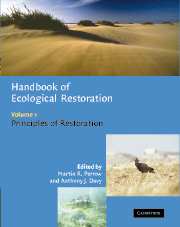Book contents
- Frontmatter
- Contents
- List of contributors
- Foreword
- Preface
- Part 1 The background
- 1 Introduction and philosophy
- 2 Rationale for restoration
- 3 The ecological context: a landscape perspective
- 4 The ecological context: a species population perspective
- 5 The evolutionary context: a species perspective
- Part 2 Manipulation of the physical environment
- Part 3 Manipulation of the chemical environment
- Part 4 Manipulation of the biota
- Part 5 Monitoring and appraisal
- Index
- References
5 - The evolutionary context: a species perspective
Published online by Cambridge University Press: 29 December 2009
- Frontmatter
- Contents
- List of contributors
- Foreword
- Preface
- Part 1 The background
- 1 Introduction and philosophy
- 2 Rationale for restoration
- 3 The ecological context: a landscape perspective
- 4 The ecological context: a species population perspective
- 5 The evolutionary context: a species perspective
- Part 2 Manipulation of the physical environment
- Part 3 Manipulation of the chemical environment
- Part 4 Manipulation of the biota
- Part 5 Monitoring and appraisal
- Index
- References
Summary
INTRODUCTION
The restoration of a process
The emerging science of restoration ecology has long been influenced by genetic and evolutionary ideas. The seminal work of A. D. (Tony) Bradshaw and his colleagues in the 1970s on the reclamation of industrial wasteland was fundamentally based on studies of the evolution and selection of metal-tolerant plants (Smith & Bradshaw, 1979; Bradshaw & McNeilly, 1981). In tracing the transition in the UK Nature Conservation movement from ‘nature preservation’ to ‘creative conservation’ Sheail et al. (1997) note that the first attempts to create species-rich grassland communities on road verges and amenity areas emphasised the importance of using local cultivars and plants from native sources (Wells et al., 1982). At the same time, largely in North America, the foundations of conservation genetics were being laid by Michael Soulé and others in a series of texts which emphasised the genetic aspects of small population size and species extinctions (e.g. Soulé & Wilcox, 1980; Frankel & Soulé, 1981). As we shall see, the evolutionary implications of small population size and scarcity are recurring themes in restoration ecology.
Accompanied by developments in the underpinning science of ecology, these strands have brought us to a contemporary view of restoration science which emphasises process and function. The modern paradigm is the restoration not of a species assemblage or community but of a functioning ecosystem, which includes the process of genetic and evolutionary change.
- Type
- Chapter
- Information
- Handbook of Ecological Restoration , pp. 66 - 80Publisher: Cambridge University PressPrint publication year: 2002
References
- 5
- Cited by



